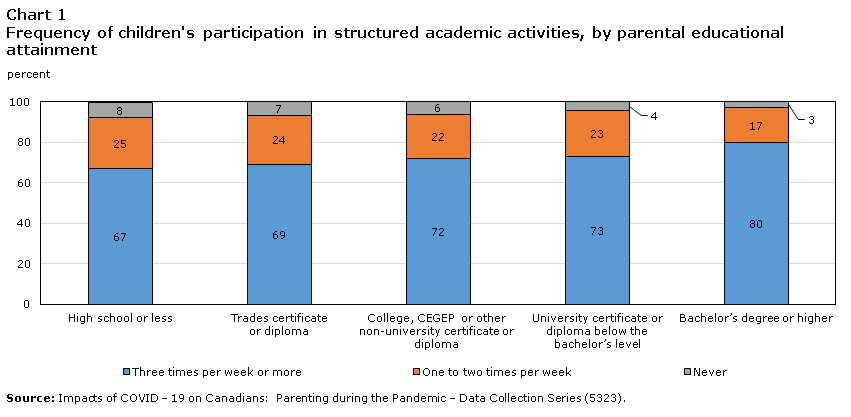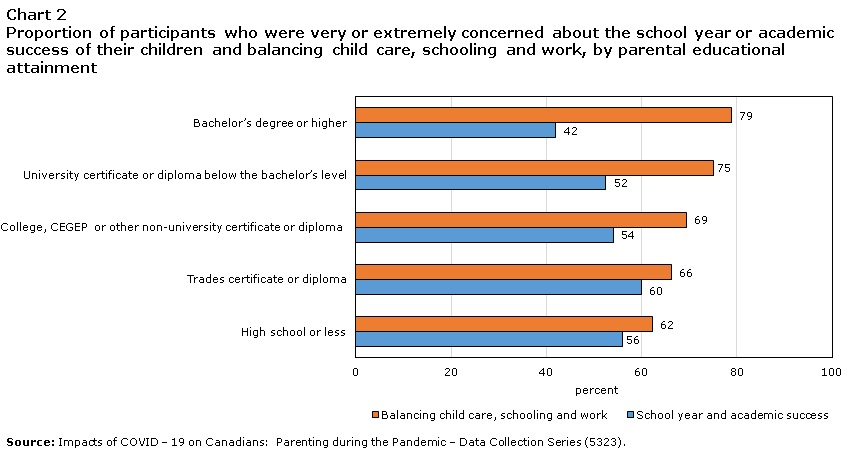 StatCan COVID-19: Data to Insights for a Better Canada Parents supporting learning at home during the COVID-19 pandemic
StatCan COVID-19: Data to Insights for a Better Canada Parents supporting learning at home during the COVID-19 pandemic
Archived Content
Information identified as archived is provided for reference, research or recordkeeping purposes. It is not subject to the Government of Canada Web Standards and has not been altered or updated since it was archived. Please "contact us" to request a format other than those available.
by Edith Greenlee and Alana Reid
Text begins

The COVID-19 pandemic has had an unprecedented impact on Canadian parents and their children. Overnight, parents became increasingly involved in their children’s education, as schools across the country closed and learning activities were moved online.
From June 9 to 22, 2020, over 32,000 parents or guardians of children up to 14 years of age participated in an online crowdsourcing data collection about the family dynamics, child care situation and at-home learning of Canadian families during the COVID-19 pandemic. Unlike other surveys conducted by Statistics Canada, crowdsourcing data are not collected under a design using probability-based sampling. As a result, the findings reflect only the responses of those who completed the questionnaire and cannot be generalized to the entire Canadian population. In fact, readers should note that a large proportion of crowdsourcing participants who voluntarily completed this online questionnaire between June 9 and June 22 were women, were born in Canada, and had a bachelor’s degree or higher.
The frequency of children’s participation in academic activities increased with the level of parental education
During the pandemic, provincial and territorial ministries of education introduced new online learning resources to support children and their parents with continuing their schooling activities in the wake of school closures. Among other activities, crowdsourcing participants were asked how frequently their school-aged childrenNote engaged in structured academic activities such as worksheets, online school resources and other educational resources in a typical week during the pandemic.
Overall, the majority of participants (77%) reported that their children engaged in these academic activities three times per week or more, with a further 19% reporting their children engaged in such activities one to two times per week. Four percent of participants said that their children never engaged in structured academic activities.
There are various factors which may facilitate learning from home, such as the availability of learning materials, access to internet-enabled devices, or having a quiet space to learn at home.Note Parental education has also been shown to be positively correlated with their children’s academic performance.Note
Eighty percent of participants with a bachelor's degree or higher reported that their children engaged in structured academic activities at home three times per week or more, compared with 72% of participants with a college certificate or diploma, 69% of those with a trades certificate or diploma and 67% of participants with a high school diploma or less.

Data table for Chart 1
| Parent or guardian’s highest level of educational attainment | Three times per week or more | One to two times per week | Never |
|---|---|---|---|
| percent | |||
| High school or less | 67 | 25 | 8 |
| Trades certificate or diploma | 69 | 24 | 7 |
| College, CEGEP or other non-university certificate or diploma | 72 | 22 | 6 |
| University certificate or diploma below the bachelor’s level | 73 | 23 | 4 |
| Bachelor’s degree or higher | 80 | 17 | 3 |
| Source: Impacts of COVID – 19 on Canadians: Parenting during the Pandemic – Data Collection Series (5323). | |||
Participants’ concerns related to their children’s school year and academic success varied by their education level
The concerns expressed by participants for their children’s school year and academic success also varied by their level of education. Greater proportions of participants who had attained a high school diploma or less (56%), a trades certificate or diploma (60%), a college, CEGEP or other non-university certificate or diploma (54%), or a university certificate or diploma below the bachelor’s level (52%) reported being very or extremely concerned about their children’s school year and academic success compared with participants with a bachelor’s degree or higher (42%).
Educational attainment tends to be associated with higher levels of income. A recent Statistics Canada study found that children in higher income families had greater access to internet-enabled devices that were conducive to learning. This may help to explain why parent participants with higher levels of education are less likely to be very or extremely concerned about the academic success of their children. It may be that they are better able to access the resources needed to support their children in academic pursuits.

Data table for Chart 2
| Parent or guardian’s highest level of educational attainment | School year and academic success | Balancing child care, schooling and work |
|---|---|---|
| percent | ||
| High school or less | 56 | 62 |
| Trades certificate or diploma | 60 | 66 |
| College, CEGEP or other non-university certificate or diploma | 54 | 69 |
| University certificate or diploma below the bachelor’s level | 52 | 75 |
| Bachelor’s degree or higher | 42 | 79 |
| Source: Impacts of COVID – 19 on Canadians: Parenting during the Pandemic – Data Collection Series (5323). | ||
On the other hand, a higher proportion of participants with a bachelor’s degree or more reported being very or extremely concerned about balancing child care, schooling and work than parents with high school or less. Nearly four-fifths (79%) of parents with a bachelor’s degree or higher reported this concern, compared with 62% of parents with high school or less.
A higher proportion of participants whose family included a child with a disability reported being very or extremely concerned about their child’s academic success
Although the same proportion (77%) of parents of children with and without a disability reported that their children engaged in structured academic activities three times per week or more, 59% of participants whose children had a disability reported being very or extremely concerned about the school year and their children’s academic success, compared with 42% of parents of children without disabilities.
Children with disabilities may require a greater amount of their parents' time for help with not only their school activities, but also with other daily activities of living. A higher proportion of these participants (32%) also reported spending at least ten hours or more per week supporting their children’s learning compared to participants whose families did not include a child with a disability (23%).
Methodology
This study is based on data from the Impacts of COVID-19 on Canadians: Parenting during the Pandemic: Data Collection Series. This crowdsourcing online questionnaire was designed to collect information about family concerns and activities during COVID-19 from parents of children aged 0 to 14 living in Canada. From June 9 to June 22, 2020, over 32,000 participants completed the voluntary online questionnaire. Readers should note that crowdsourcing data are not collected under a sample design using probability-based sampling. As a result, the findings cannot be applied to the overall Canadian population. A benchmarking factor based on demographic projections of the number of families with children aged exclusively 0 to 5 or 6 to 14 years or a mixture of both age groups by province as of January 2020 was used for every participant to compensate for the over- or under-representation of the participants. As results were benchmarked to the number of families, the education level of the parents or guardians could not be included in the strategy.
- Date modified:
